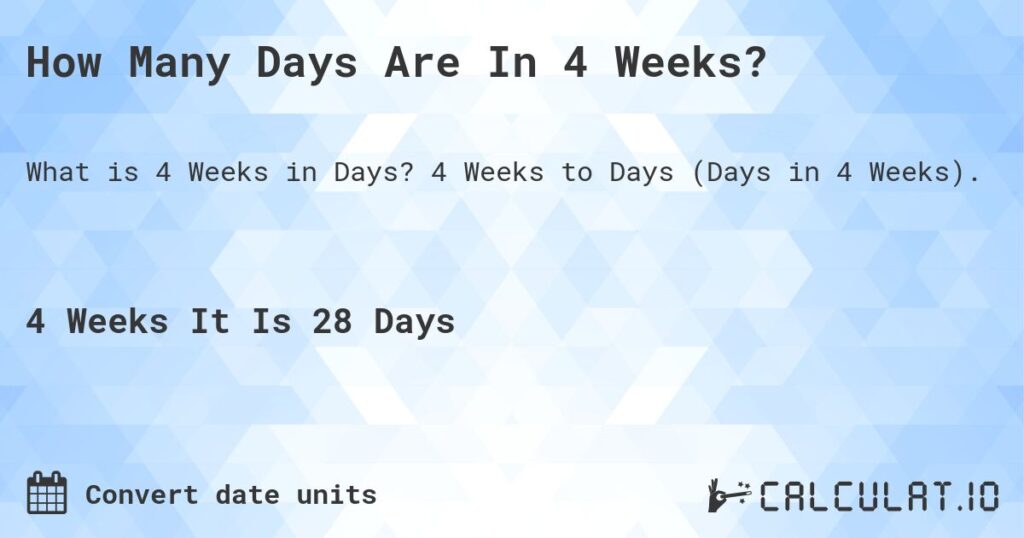How Many Days Are in 4 Weeks?
A week is a unit of time consisting of a certain number of days. The exact number of days in a week varies across cultures and throughout history, but the most widely used system today is the 7-day week.In this system, a week is made up of 7 consecutive days, typically named:
- Monday
- Tuesday
- Wednesday
- Thursday
- Friday
- Saturday
- Sunday
This 7-day cycle repeats continuously, with Sunday usually considered the start of a new week.So if we have 4 of these 7-day weeks in a row, how many total days is that? To calculate, we simply multiply the number of days per week by the number of weeks:
Therefore, there are 28 days in 4 weeks.This is a straightforward mathematical calculation, but the 7-day week and the concept of a “week” in general have a long and interesting history. Let’s dive a bit deeper into the origins and significance of the week.
History of the Week
The 7-day week structure is believed to have originated with the ancient Babylonians, who divided the month into 4 seven-day periods corresponding to the moon’s phases. The Babylonians named the days after the sun, moon, and five known planets at the time.The concept of the week was later adopted by the ancient Hebrews, who fixed the 7th day (Saturday) as a day of rest and worship, known as the Sabbath. This practice was codified in the Ten Commandments of the Torah.The 7-day week was further disseminated by the Roman Empire and early Christianity. The Roman astrological week named the days after the sun, moon, and five planets, but the Christian week focused on Sunday as the Sabbath, in honor of the resurrection of Jesus Christ.The 7-day week became the standard in Western civilization and later spread worldwide through European colonization and globalization. Today, the 7-day week is the most widely used system, with only a few exceptions:
- The French Revolutionary Calendar (1793-1805) used a 10-day week called a décade.
- The Soviet Union experimented with a 5-day and later 6-day week in the 1920s.
- The International Organization for Standardization (ISO) defines the week as Monday to Sunday for the purpose of date representation.
However, the 7-day week remains the dominant system globally for social, religious, and administrative purposes.
Significance of the Week
The week has great significance in many cultures and religions:
- In Judaism and Christianity, the week is structured around the Sabbath, a day of rest and worship.
- In Islam, Friday is the day of communal prayer and rest.
- In Hinduism, each day of the week is associated with a different deity.
- In Chinese culture, each day of the week is named after a celestial body.
The week also has practical significance in organizing time and work. The 5-day work week with Saturday and Sunday as the weekend is a common standard in many countries. Payroll, school schedules, and business operations are often structured around the 7-day week.Socially, the week provides a regular rhythm to life, with weekdays for work and weekends for rest and recreation. Weekends are times for family, friends, hobbies, and relaxation.
Variations in Week Length
While the 7-day week is the most widely used system, there are some variations:
- The French Revolutionary Calendar (1793-1805) used a 10-day week called a décade. This was part of the radical changes made during the French Revolution.
- The Soviet Union experimented with a 5-day and later 6-day week in the 1920s, with the goal of increasing productivity and reducing religious influence. However, this was unpopular and abandoned by 1940.
- The International Organization for Standardization (ISO) defines the week as Monday to Sunday for the purpose of date representation. However, this is primarily for technical purposes and does not affect social or religious practices.
These variations demonstrate that while the 7-day week is deeply ingrained in most cultures, the exact structure and significance can differ.
Conclusion
In summary, there are 28 days in 4 weeks, based on the most widely used 7-day week structure. This system has ancient origins and great cultural significance, providing a regular rhythm to life and organizing time for work, worship, and recreation.While the 7-day week is dominant globally, there have been some historical variations in week length. However, the 7-day week remains the standard for social, religious, and administrative purposes in most parts of the world.
FAQ Section
Q1: How many days are in a month?
A typical month has about 30 or 31 days, but February has 28 days in a common year and 29 days in a leap year.
Q2: How many weeks are in a year?
There are 52 weeks in a year, which equals 365 days (or 52 weeks and 1 day in a common year).
Q3: Is there a difference between a week and a business week?
Yes, a standard week consists of 7 days, while a business week typically refers to the 5 days from Monday to Friday.
Q4: How many days are in 10 weeks?
To calculate the number of days in 10 weeks, multiply 10 weeks by 7 days/week, which equals 70 days.
Q5: Are there any variations in the length of weeks in different cultures?
While the 7-day week is widely used, some cultures have different week lengths or structures, such as the 10-day week in the French Revolutionary Calendar.
Summary Table
| Weeks | Days |
|---|---|
| 1 | 7 |
| 2 | 14 |
| 3 | 21 |
| 4 | 28 |
For further reading, you can refer to the Wikipedia page on Week for more detailed information.



